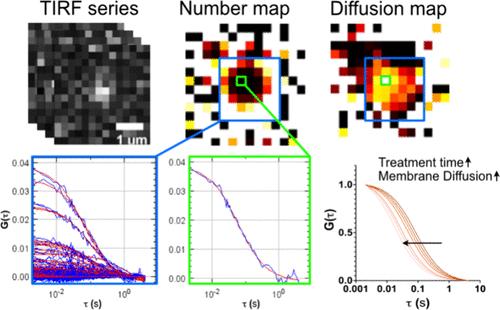利用成像荧光相关光谱技术筛选膜活性抗菌化合物的活菌试验
IF 6.7
1区 化学
Q1 CHEMISTRY, ANALYTICAL
引用次数: 0
摘要
个人卫生行业越来越需要开发新一代有效的抗菌活性物质,作为功能性抗菌成分和防腐剂。攻击细菌膜的抗菌剂是一个有吸引力的目标,因为细菌膜的结构组成相对保守,细菌不容易改变而不影响膜内蛋白的功能。然而,目前的筛选是缓慢的,需要快速的筛选方法来克服现有的筛选工具耗时的性质。成像全内反射-荧光相关光谱技术(ITIR-FCS)是一种测量膜动力学和识别膜变化的高精度技术。因此,我们将ITIR-FCS与一种分割算法结合起来,自动识别细菌细胞,以筛选抗菌化合物对细菌膜动力学的影响,作为抗菌药物浓度和培养时间的函数。这允许在不到30分钟内评估膜活性,并在2小时内生成剂量-反应曲线。该技术在较低浓度下检测抗菌活性,比常用的药敏试验快一个数量级。本文章由计算机程序翻译,如有差异,请以英文原文为准。

A Live Bacterial Screening Assay for Membrane-Active Antimicrobial Compounds Using Imaging Fluorescence Correlation Spectroscopy
There is a growing need in the personal hygiene industry to develop a new generation of effective antimicrobial actives, to be used as functional antibacterial ingredients and preservatives. Antimicrobials that attack bacterial membranes are an attractive target due to the relatively conserved structure compositions of the bacterial membrane, which bacteria cannot easily change without influences on the function of membrane-embedded proteins. However, current screening is slow and there is a demand for rapid screening methodologies to overcome the time-consuming nature of existing screening tools. Imaging total internal reflection-fluorescence correlation spectroscopy (ITIR-FCS) is a powerful technique that can measure membrane dynamics and identify changes with high accuracy and precision. We therefore combine ITIR-FCS with a segmentation algorithm to automatically identify bacterial cells to screen the effect of antimicrobial compounds on the dynamics of bacterial membranes as a function of antimicrobial concentration and incubation time. This allows to assess membrane activity within less than 30 min and generates dose–response curves within a span of 2 h. The technique detects antimicrobial activity at lower concentrations and an order of magnitude faster than commonly used susceptibility testing assays.
求助全文
通过发布文献求助,成功后即可免费获取论文全文。
去求助
来源期刊

Analytical Chemistry
化学-分析化学
CiteScore
12.10
自引率
12.20%
发文量
1949
审稿时长
1.4 months
期刊介绍:
Analytical Chemistry, a peer-reviewed research journal, focuses on disseminating new and original knowledge across all branches of analytical chemistry. Fundamental articles may explore general principles of chemical measurement science and need not directly address existing or potential analytical methodology. They can be entirely theoretical or report experimental results. Contributions may cover various phases of analytical operations, including sampling, bioanalysis, electrochemistry, mass spectrometry, microscale and nanoscale systems, environmental analysis, separations, spectroscopy, chemical reactions and selectivity, instrumentation, imaging, surface analysis, and data processing. Papers discussing known analytical methods should present a significant, original application of the method, a notable improvement, or results on an important analyte.
 求助内容:
求助内容: 应助结果提醒方式:
应助结果提醒方式:


